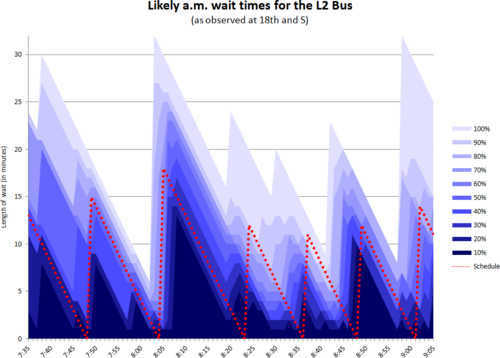Waiting for the L2
The L2 bus travels along Connecticut Avenue from Friendship Heights, detours through Adams Morgan, down 18th and New Hampshire through Dupont, and then along K Street to McPherson Square. It also runs right past my window. I started keeping track of its actual times and compared them to the schedule. (Click for a bigger version).
This chart shows how much time you are likely to wait at 18th and S based on when you show up. The darkest area is 10% of the buses: for example, at exactly 8:00, 10% of the time a bus will come within 3 minutes, but 90% of the time it will take longer than 3 minutes. The lightest area is 100% of the buses (that I’ve observed); at 8:00, 100% of the time a bus will come within 8 minutes (not bad).
The red dotted line represents the schedule. The WMATA trip planner reports that this bus should arrive at 7:48, 8:04, 8:23, 8:36, 8:48, 9:01, and 9:16. If all buses showed up exactly on time, the entire chart would coincide with the red line.
You can see that many of the triangular areas deviate to the left of the red line. That means that the bus often shows up early. If you get to the stop at 8:46, two minutes before the scheduled 8:48 arrival, 30% of the time the bus will show up within four minutes, but 70% of the time it will take 12 minutes or more because 70% of the time this bus shows up before 8:46. And it’s been as early as 8:41 (that’s where the tall light blue spike appears), which means to be safe and avoid risking a 23-minute wait for a 9:01 bus that may show up at 9:04, you have to arrive to the stop seven minutes ahead of time.
The tighter the triangle, the more accurate the bus’s appearances. As you can see, the 8:04 is pretty good, only deviating to the left (early) occasionally and then not very far early. At the same time, it’s not late much; the big dark triangle means that the bus isn’t usually more than a couple minutes late either. On the other hand, its light colored spike is very high, meaning that occasionally even if you show up a minute early you might be stuck waiting 28 or 32 minutes if the 8:23 is late.
The 8:23 and 8:36 appearances aren’t very consistent, leading to the lack of visible shape in those areas. Those buses are often early and often late, and several times have shown up within one minute of each other.
You can see all my data on this Google Spreadsheet. The first tab is my direct observations; the second tab is the calculated data that generated the chart.
In conclusion, the 8:04 is fairly reliable, while the later buses are not so much. WMATA is working on offering real-time bus info which would help since someone could see how much time actually remained until the next bus, and see this before leaving home. The other big recommendation I see from this data is for the drivers to try harder to avoid being early. They should wait at certain key stops until the correct departure time. That way, commuters could at least know for certain that if they showed up a minute or two before the bus’s scheduled arrival, they wouldn’t be left waiting at the stop for 20 minutes.

